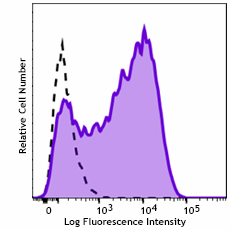- Clone
- QA20A90 (See other available formats)
- Regulatory Status
- RUO
- Other Names
- E-selectin, ELAM-1, LECAM-1
- Isotype
- Mouse IgG1, κ

-

TNF-α stimulated human endothelial cells (HUVEC) stained with anti-human CD62 (clone QA20A90) PE (filled histogram), or PE mouse IgG1, κ isotype control (open histogram).
| Cat # | Size | Price | Quantity Check Availability | ||
|---|---|---|---|---|---|
| 384103 | 25 tests | $115.00 | |||
| 384104 | 100 tests | $250.00 | |||
CD62E (also known as E-selectin, ELAM-1, and LECAM-1) is a 115 kD type I membrane protein and a member of the selectin family. CD62E is highly expressed on activated endothelial cells (IL-2, TNF-α, other cytokines can increase expression) and can also be expressed on endothelial cells in the skin, bone marrow and placenta. CD62E is involved in tethering and leucocyte rolling on activated endothelium at inflammatory sites and may also play a role in tumor metastasis and angiogenesis. CD62E binds to both Siayl Lewis X (CD15s) and PSGL-1 (CD162). The HCD62E antibody has been shown to recognize human CD62E and be useful for flow cytometry.
Product Details
- Verified Reactivity
- Human
- Antibody Type
- Recombinant
- Host Species
- Mouse
- Formulation
- Phosphate-buffered solution, pH 7.2, containing 0.09% sodium azide and BSA (origin USA)
- Preparation
- The antibody was purified by affinity chromatography and conjugated with PE under optimal conditions.
- Concentration
- Lot-specific (to obtain lot-specific concentration and expiration, please enter the lot number in our Certificate of Analysis online tool.)
- Storage & Handling
- The antibody solution should be stored undiluted between 2°C and 8°C, and protected from prolonged exposure to light. Do not freeze.
- Application
-
FC - Quality tested
- Recommended Usage
-
Each lot of this antibody is quality control tested by immunofluorescent staining with flow cytometric analysis. For flow cytometric staining, the suggested use of this reagent is 5 µL per million cells in 100 µL staining volume or 5 µL per 100 µL of whole blood. It is recommended that the reagent be titrated for optimal performance for each application.
- Excitation Laser
-
Blue Laser (488 nm)
Green Laser (532 nm)/Yellow-Green Laser (561 nm)
- Application Notes
-
Clone QA20A90 completely blocks the binding of reference clone HCD62E on target cells.
- RRID
-
AB_2924587 (BioLegend Cat. No. 384103)
AB_2924587 (BioLegend Cat. No. 384104)
Antigen Details
- Structure
- Member of the selectin family, 115 kD type I membrane protein; contains one C-type lectin domain and one EGF-like domain
- Distribution
-
Highly expressed on activated endothelial cells (IL-2, TNF-α, other cytokines can increase expression); can also be expressed on endothelial cells in the skin, bone marrow and placenta.
- Function
- Involved in tethering and leucocyte rolling on activated endothelium at inflammatory sites, may also play a role in tumor metastasis and angiogenesis
- Ligand/Receptor
- Siayl Lewis X (CD15s) and PSGL-1 (CD162) bind to CD62E. Recently, CLA (cutaneous lymphocyte antigen) has also been reported to interact with CD62E
- Antigen References
-
- Collins T, et al. 1991. J Biol Chem. 266:2466-73.
- Bevilacqua MP, et al. 1987. Proc Natl Acad Sci. USA 84:9238-42.
- Berg EL, et al. 1991. J Exp Med. 174:1461-6.
- Lawrence MB, et al. 1993. J Immunol. 151:6338-46.
- Walz G, et al. 1990. Science. 250:1132-5.
- Gene ID
- 6401 View all products for this Gene ID
- UniProt
- View information about CD62E on UniProt.org
Other Formats
View All CD62E Reagents Request Custom Conjugation| Description | Clone | Applications |
|---|---|---|
| PE anti-human CD62E Recombinant Antibody | QA20A90 | FC |
| Purified anti-human CD62E Recombinant Antibody | QA20A90 | FC |
Compare Data Across All Formats
This data display is provided for general comparisons between formats.
Your actual data may vary due to variations in samples, target cells, instruments and their settings, staining conditions, and other factors.
If you need assistance with selecting the best format contact our expert technical support team.
-
PE anti-human CD62E Recombinant Antibody

TNF-α stimulated human endothelial cells (HUVEC) stained wit... -
Purified anti-human CD62E Recombinant Antibody

TNF-α stimulated human endothelial cells (HUVEC) stained wit...
